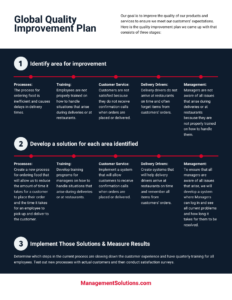An organization’s reputation relies on the quality of its services or products. Creating and implementing an internal quality assurance (QA) policy is a proactive approach for an organization to assure its stakeholders, such as customers and top management, that its processes, products, and services meet a certain level of quality. An internal quality assurance policy template streamlines the process of effectively implementing an internal QA system within an organization.
An internal quality assurance policy template provides a framework for an organization to establish and maintain a quality management system. It outlines the organization’s quality objectives, responsibilities, and procedures for ensuring that its products or services meet the specified requirements. The template also helps to ensure that the organization’s quality management system is aligned with relevant standards and regulations.
Key Components of an Internal Quality Assurance Policy
Purpose and Scope
The purpose of this policy is to define the organization’s commitment to quality and to establish a framework for achieving and maintaining quality. The scope of this policy includes all aspects of the organization’s activities, including product development, production, delivery, and customer service.
Roles and Responsibilities
This section outlines the roles and responsibilities of key personnel involved in the quality assurance process. These may include the quality assurance manager, quality control inspectors, and production supervisors. The policy should clearly define the responsibilities of each individual and how they will interact with each other to ensure that quality standards are met.
Quality Objectives
The policy should define the organization’s quality objectives, which are measurable goals that the organization strives to achieve. These objectives should be specific, measurable, achievable, relevant, and time-bound.
Quality Assurance Procedures
This section describes the specific procedures that will be used to monitor and evaluate the quality of the organization’s products or services. These procedures may include quality audits, inspections, and testing. The policy should also define the frequency of these audits and inspections.
Steps for Implementing an Internal Quality Assurance System
Identify Key Stakeholders
The first step is to identify the key stakeholders who will be affected by the internal quality assurance system. This includes customers, employees, suppliers, and regulators.
Define Quality Objectives
The next step is to define the quality objectives that the organization wants to achieve. These objectives should be specific, measurable, achievable, relevant, and time-bound.
Develop Quality Assurance Procedures
Once the quality objectives have been defined, the organization needs to develop quality assurance procedures that will help it achieve these objectives. These procedures should include quality audits, inspections, and testing.
Implement the Quality Assurance System
Once the quality assurance procedures have been developed, the organization needs to implement the quality assurance system. This involves training employees on the new procedures and monitoring the system to ensure that it is working properly.
Conclusion
An internal quality assurance (QA) policy template provides a solid foundation for an organization to establish and maintain a comprehensive quality management system. With a well-structured template, organizations can streamline the implementation of effective QA processes, ensuring that their products or services consistently meet customer requirements and applicable standards. By prioritizing quality and customer satisfaction, organizations can build a strong reputation and drive business success.
Moreover, utilizing an internal quality assurance policy template enables organizations to optimize their operations, enhance efficiency, and minimize the risk of defects or non-compliance. Embracing a culture of continuous improvement through internal QA initiatives not only helps organizations stay competitive but also positions them for long-term growth and sustainability.
FAQ
What is an internal quality assurance policy template?
An internal quality assurance policy template is a document that provides a framework for organizations to establish and maintain a quality management system. It outlines the organization’s quality objectives, responsibilities, and procedures for ensuring that its products or services meet the specified requirements.
What are the benefits of using an internal quality assurance policy template?
Using an internal quality assurance policy template can help organizations to improve the quality of their products or services, reduce costs, and increase efficiency. It can also help to ensure that the organization’s quality management system is aligned with relevant standards and regulations.
What are the key components of an internal quality assurance policy?
The key components of an internal quality assurance policy include the purpose and scope of the policy, the roles and responsibilities of key personnel, the organization’s quality objectives, and the quality assurance procedures that will be used to monitor and evaluate the quality of the organization’s products or services.
